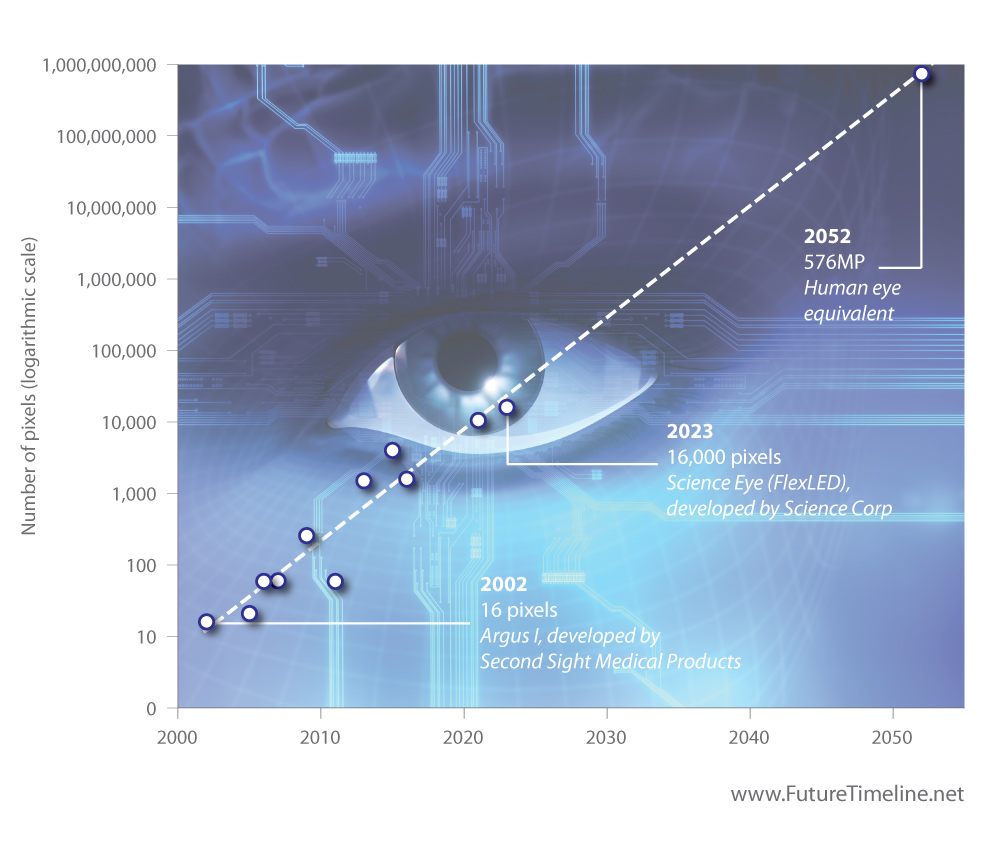
Bionic eye pixel resolutions, 2000-2050 This graph illustrates the rapid progress of bionic eye pixel resolutions from 2000 to 2050. The y-axis shows the number of pixels produced by electrode arrays in various artificial retinas and other visual prostheses, displayed on a logarithmic scale. In 2002, researchers at Second Sight Medical Products created an early bionic eye prototype known as the Argus I. Containing just 16 electrodes, it offered basic functionality that enabled blind patients to detect when lights turned on or off, track simple motion, count discrete objects, and distinguish shapes within their environment. A more advanced model, the Argus II, entered clinical trials in 2007 with 60 electrodes, offering improved visual perception. Over the following decade, companies worldwide significantly increased the pixel resolution of visual implants, hinting at an exponential trend comparable to Moore's Law. The Iridium Medical Technology Company, based in Hsinchu City, Taiwan, developed a retinal prosthesis capable of generating 4,000 pixels – enough for patients "to recognise faces and objects, read big-print books, and navigate easily through life." In 2021, scientists at the Swiss Federal Institute of Technology Lausanne (EPFL) introduced POLYRETINA, a high-density epiretinal implant featuring 10,498 pixels. Tested successfully in animal models, it demonstrated far greater field coverage and resolution than earlier systems. Two years later, in 2023, a startup called Science Corp unveiled its Science Eye, a radically different optogenetic microLED implant with 16,000 pixels, designed to stimulate genetically modified retinal cells and restore partial sight. Science Corp's technology is notable not just for the pixel count, but for potentially being scalable: the company stated that the system could be extended to "hundreds of thousands of pixels" in the future. If the exponential growth in bionic eye resolution continues, these advances could transform vision restoration in the coming decades. Future eye implants in the 2030s and 40s may deliver smooth, full-colour images instead of the coarse, monochrome patterns produced by current devices. Maintaining this rate of progress could eventually yield human-level sight. Scientists estimate that the human retina's photoreceptors provide a resolution roughly equivalent to a 576-megapixel digital camera. Based on the current trend, this resolution could be reached by 2052, as shown in the graph below. Further breakthroughs may push beyond natural limits, producing superhuman vision in the 2060s and beyond. Even healthy individuals might choose to replace their biological eyes with enhanced, cybernetic versions that incorporate additional features – such as real-time zoom, night vision, or continuous video recording.
Sources: Notes on the Resolution and Other Details of the Human Eye, ClarkVision.com: "Mark Humayun, MD, PhD, implanted six subjects with the first generation 16-electrode (Argus™ 16) between 2002 and 2004. The study demonstrated the ability of participants to detect when lights are on or off, describe an object's motion, count discrete items, as well as locate and differentiate basic objects in an environment." Visual Prostheses – Devices, Institute for Ophthalmic Research: Real-life Story of the 'Bionic Eye,' the Argus II, Retina Specialist: Wearable Computer Vision Systems for a Cortical Visual Prosthesis, The Computer Vision Foundation: Patents Assigned to IRIDIUM MEDICAL TECHNOLOGY CO, LTD., Justia Patents: An earlier version of the website text stated: "IMTC enables patients to recognize faces and objects, read big-print books (font size > 14 pt.), and navigate easily through life by using its 4,000-pixel device." Advances in retinal prosthesis systems, Therapeutic Advances in Ophthalmology: Seeing the future: the bionic eye, Australian Academy of Science: "Here we show a wide-field, high-density and high-resolution photovoltaic epiretinal prosthesis for artificial vision (POLYRETINA). The prosthesis embeds 10,498 physically and functionally independent photovoltaic pixels, allowing for wide retinal coverage and high-resolution stimulation." "Hodak [...] runs through images on his laptop, pointing out the form factor of the Science Eye and how many pixels the team has been able to jam into the device's wafer-thin microLED. The number stands at an impressive 16,000, allowing for a resolution he says is about 'eight times better than an iPhone 13.'"
Posted: 11th August 2019. Last updated: 22nd October 2025.
If you enjoy our content, please consider sharing it:
|







